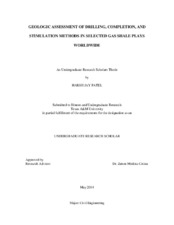| dc.description.abstract | The United States regularly imports majority of the transportation oil, and several TCF of natural gas annually. Nevertheless, there is very large resource of natural gas in unconventional reservoirs, with over 2,200 TCF of natural gas in just the gas shale formations that have been identified in the world energy consortium. The natural gas in shales and other unconventional reservoirs can be easily used to generate electricity, or it can be turned into liquids and used by the transportation industry. However, despite of its substantial economic advantage over conventional gas plays, the petroleum industry is still having difficulty determining the best drilling, completion, and stimulation methods to properly develop gas shale plays worldwide. The underlying reason for this problem is primarily the limitations to technological resources and data processing inference methods to appropriately assess the geologic characteristics of the shale formations. The current method for selecting the best drilling, completion, and stimulation employs trial and error to verify what works best for each shale basin. Industry needs to develop geologic and technical constraints to determine the best way to recover gas from a shale play.
The objective of this research is to (1) identify key geologic parameters that affect drilling, completion, and stimulation decisions for each gas shale play, (2) select the best drilling, completion, and stimulation methods to optimize gas shale recovery in given gas shale plays, and (3) present these findings by the use of a summary table based decision making model, where a logic-based decision model will reflect the carousal dependencies between the play’s geologic characteristics and the efficiency of the technologies used.
Based on the literature review I have done for chosen gas shale basins, I have identified seven key geologic constraints that influence drilling, completion, and stimulation practices. These are depositional environment, total organic content (TOC), average gas content, shale mineralogy, shale thickness, and reservoir pressure (Agrawal, 2010). Next, I identified different drilling, completion, and stimulation trends in the industry for the different shale plays. | en |


